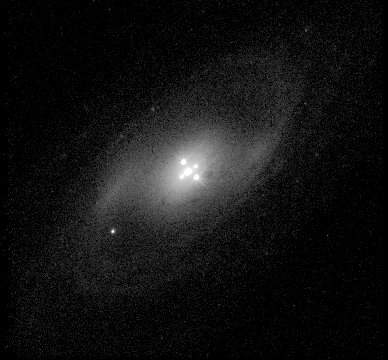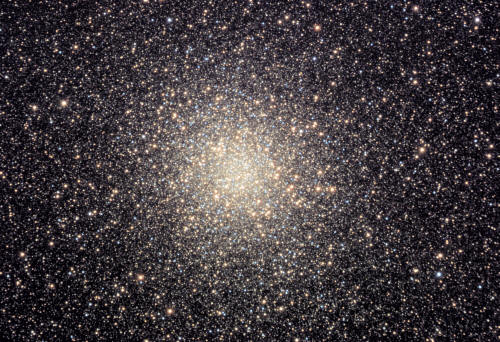|
1 -
A Conceptual Model
of Interstellar Space
Modern astronomers claim that the only forces capable of forming and
driving the galaxies that make up the universe are gravitational and
magnetic fields. In order to judge whether this or any alternative
explanations are reasonable, we have to be able to visualize the
relative sizes of stars and the distances between them.
In order to do this, we need a scale model that humans can relate
to. It is very difficult, if not impossible, for us to relate
conceptually to how far something is from us when we are told its
distance is, say 14 light years.
We know that is a long way - but
HOW long?
Burnham's Model
In his "Celestial Handbook", Robert Burnham, Jr. presents a model
that offers us a way to get an intuitive feel for some of these
tremendous distances. The distance from the Sun to Earth is called
an Astronomical Unit (AU); it is approximately 93 million miles.
The
model is based on the coincidental fact that the number of inches in
a statute mile is approximately equal to the number of astronomical
units in one light year. So, in our model, we sketch the orbit of
the Earth around the Sun as a circle, two inches in diameter. That
sets the scale of the model. One light year is one mile in the
model.
The Sun is approximately 880,000 miles in diameter. In the model
that scales to 880,000 / 93,000,000 = 0.009 inches; (Approximately
1/100 of an inch in diameter). A very fine pencil point is needed to
place it at the center of the (one inch radius) circle that
represents the Earth's orbit.
In this model, Pluto is an invisibly small speck approximately three
and a half feet from the Sun.
All the other planets follow almost
circular paths inside of this 3.5 foot orbit. If a person is quite
tall, he or she may just be able to spread their hands far enough
apart to encompass the orbit of this outer planet. That is the size
of our model of our solar system. We can just about hold it in our
extended arms.
The nearest star to us is over four light-years away.
In our model, a light year is scaled down to one mile. So the
nearest star to us is four and a half MILES away in our model. So
when we model our Sun and the nearest star to us, we have two specks
of dust, each 1/100 inch in diameter, four and a half miles apart
from one another.
And this is in a moderately densely packed arm of
our galaxy!
To quote Burnham,
"All the stars are, on the average, as far from
each other as the nearest ones are from us."
Imagine, then, several
hundred billion stars scattered throughout space, each one another
Sun, each one separated by a distance of several light years
(several miles in our model) from its nearest neighbor.
Comprehend,
if you can, the almost terrifying isolation of any one star in
space" because each star is the size of a speck of dust, about 1/100
inch in diameter - and is miles from its nearest neighbor.
When viewing a photographic image of a galaxy or globular star
cluster, we must remember that the stars that make up those objects
are not as close together as they appear. A bright star will "bloom"
on a photographic plate or CCD chip. Remember the two specks of
dust, miles apart.
Even in our model, the collection of stars that makes up our Milky
Way galaxy is about one hundred thousand miles in diameter.
This is
surrounded by many hundreds of thousand of miles of empty space,
before we get to the next galaxy. And on a larger scale, we find
that galaxies seem to be found in groups - galaxy clusters. On this
gigantic scale even our model fails to give us an intuitive feeling
for the vastness of those distances.
Because the stars are so small relative to their separation, they
have only an extremely small gravitational pull on each other.
However, it is now well known that the entire volume of our galaxy
is permeated by plasma - huge diffuse clouds of ionized particles.
These electrically charged particles are not relatively far from
each other. And they respond to the extremely strong Maxwell /
Lorentz electromagnetic forces (36 powers of 10 stronger than
gravity).
It is becoming clear that galaxies are not held together
by gravity, but, rather, by dynamic electromagnetic forces.
Gravitational Lensing
As an application of the insight afforded by Burnham's model let us
consider the oft proclaimed phenomenon known as
gravitational lensing.
If a far distant object lines up precisely with Earth and
an intermediate object that has enough mass, Einstein's theory of
relativity suggests that the light from the farther object will be
bent - producing multiple images of that distant object when it is
observed from Earth.
Gravitational lensing is now a standard
explanation used by mainstream astronomy to discredit any
observations of quasar pairs situated very near their parent
galaxies. We are told that any images of this sort are "mirages" due
to gravitational lensing.
Once this explanation is accepted by a
gullible public, the way is cleared for its continued use, no matter
how improbable its repeated occurrence is.
An image of the The "Einstein Cross" is shown below.
NASA claims
that the four small quasar objects flanking the central bright core
of the galaxy represent only a single quasar located in the far
distance directly behind the center of the galaxy - they tell us
that we are not seeing four separate quasars - this is only a
"mirage".
The reason for their conclusion that the four small quasar
images are in the deep background is that they have a vastly greater redshift value than does the central galaxy.

Spectral analysis of the region between the quasars indicates they
are connected to the galaxy by streams of Hydrogen gas (plasma).
This plasma has the same extremely high redshift value as do the
quasars. So, what we actually have are four newly formed quasars
symmetrically positioned around the active nucleus of a barred
spiral galaxy.
There is no mirage. No relativistic magic is needed
to explain what we see happening in front of our eyes.
Most important is the fact that for a foreground galaxy to
gravitationally 'lens' a background QSO, the mass of the galaxy
would have to act as if it were concentrated at the galaxy's center.
We know from the difficulties associated with galactic rotation
profiles that this does not occur.
But what is ignored by astrophysicists is the statistical
improbability of this line-up happening in the first place, let
alone over and over again.
For example, astronomers recently announced they were going to look
for gravitational lensing effects that might be occurring in the
closely packed globular cluster, M 22 (click below image).
For such a gravitational lensing effect to be visible on Earth, two stars in the cluster and
the Earth must line up - all three objects - on the same precise
straight line.

Let us calculate the probability of that happening
with any two stars in M 22.
M 22 contains on the order of 500,000 stars and is approximately 50
light-years in diameter.
Therefore, stars in the center of M22 are
separated by distances in the order of 0.5 light year. (1/2 mile in
Burnham's model.) Assume that stars in the M 22 cluster are of the
same general size as our Sun, a medium sized star, 880,000 miles in
diameter (1/100 inch in the model).
Put such a star at the center of
one face of a cube that is 0.5 LY along each edge. Assume that Earth
lies an infinite distance away on a line which is perpendicular to
that face of the cube and which passes through the centered star.
First, ask the question, what is the probability, p, that another
star lies directly on that line, at the center of the opposite face
of the cube?
Considering the average diameter of the typical star,
there are approximately 1013 non-overlapping possible star
positions on that opposite face.
So the answer to our question is:
"One out of 1013" p = 10-13
We have to remember that the center of the cluster is 50 LY (100
such cubes) deep. The probability that we will NOT get a match with
a star in any of those deeper cubes is (1-p)100.
The first two
terms of the expansion of this expression are 1 - 100p. So, (as an
approximation) the probability that we WILL get a match is
approximately the first probability multiplied by 100: 100p =
10-11.
But there are 100x100 = 104 other lines of cubes that make up the
visible face of M 22. So, we must multiply by 104. This yields an
overall approximate probability of 10-11 x 104 = 10-7 which is
one in ten million.
This answer is, of course, an approximation. But
it does reveal the futility of looking for gravitational lensing in
M 22.
This means that if astronomers see anything 'mysterious' in M 22,
they cannot, with any credibility, point to "gravitational lensing"
as being the cause.
And, if this is so in a dense cluster like M22,
it is even less likely when discussing galaxies and supposedly far
distant quasars - like the Einstein Cross.
Back to
Contents
|

